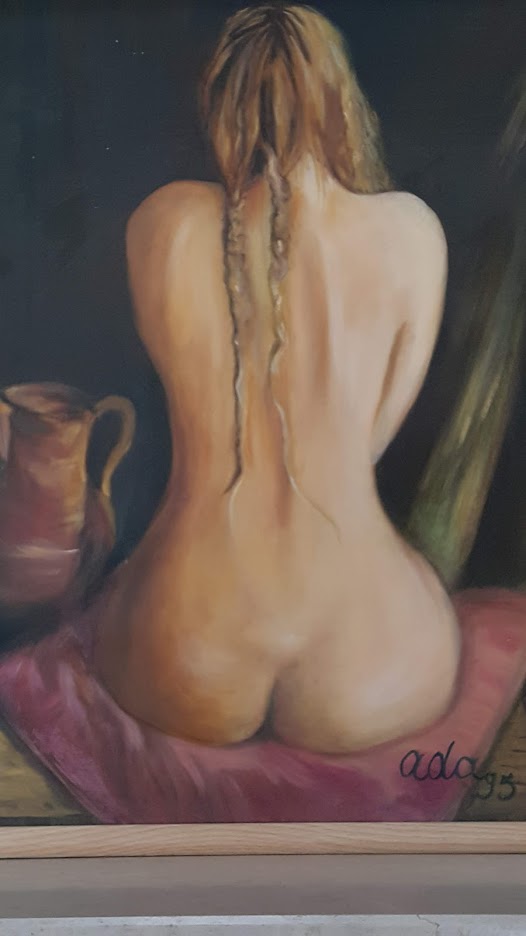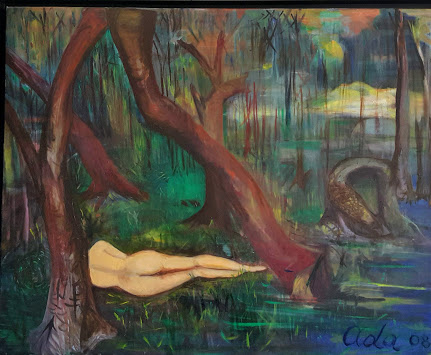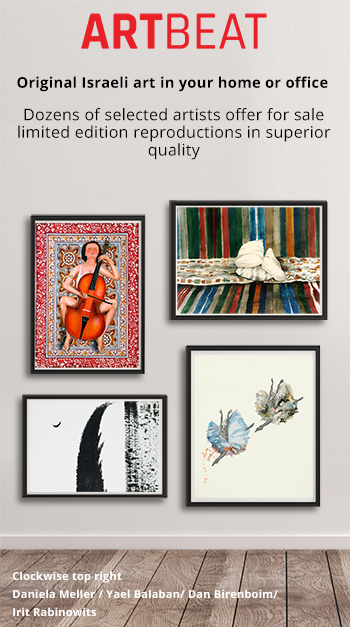Art Shows > Blue Blue
Blue Blue / Kandinof01/03/2019 to - 31/03/2019 The painter Vasily Kandinsky, who was a member of the "Blue Knight" in 1912, wrote an aesthetic and philosophical essay on the spiritual in art, especially in painting, in which he attempted to define the various values of art in a phenomenological metaphysical approach, The influence of visual vision on the experience of viewing art, in the eyes of the beholder, Kandinsky, who had musical training, based his art on the influence of colors on man, an inspiration that evokes physical feelings on the viewer. In his opinion, "the physical force, the elementary and the first derives from the color, and then creates a path in which color achieves the soul." Kandinsky sees the paintings as a sort of universal symbol with a psychological effect on the beholder and that in fact he discerns the geometric shapes and the colors. The blue color, for example, is perceived by him as 'spiritual' and 'distancing' and the shape of the triangle is perceived as dynamic - more than the shape of the square. To my deep sense, Ada Weisberg created her works, consciously or not, with the great influence of Kandinsky and his friends (Mark, Paul Klee, Picasso, Kirchner and Miller) Vasily, distinguished between three different sources of inspiration, which, in my impression, also applied to the talent and creativity of Ada, the painter: The first is: an initial impression of nature. The second is: a spontaneous expression of an inner and "spiritual" character that we call "improvisation" And the third is: the composition, in which emotions are shaped and processed again and again as a rational action and connect mind and mind to a new organization between objects and space, that is, the "composition." - the spiritual life of humanity, is likened to a large triangle similar to the pyramid and the artist, On his mission, leads the other humans to the top of this triangle through his talent. At the end of the triangle there are only a few, those artists who bring the lofty "gospel" to the other ordinary people. In particular, a double effect occurs when examining the color palette of the painters and Ada, At first, there is a purely physical effect that occurs through the eyes and stems from the beauty of the colors, which make us feel happy, as if we touched a fine object or food. This effect can cause a deeper emotion and mental tremor, a kind of "mental resonance," which is perceived as a purely spiritual phenomenon in which the colors touch and harm the soul itself. This is the "inner need" (by Kandinsky), from which art originates at its best, and is the basis for creating the harmony of shapes and colors. Through this need, an effective and effective interaction is created between the form and the human soul. Linda, like any artist, had such an "internal need" for artistic freedom, real and non-counterfeit. The process in which the works were created is mysterious, sometimes mystical, but once the artistic work is born, it becomes independent and becomes an independent, self-contained independent entity, even after the disappearance of the artist from our lives. The artist, Ada Weisberg, has left the world with works and works, for which the spectators, who look at their color, allow them to act on us and our souls, both from the heat and cold of the shades of color, and from their degree of clarity or turbidity. Ada had a real and unfaithful need to paint and express her colorful and colorful world, a need that had grown in need and truthfulness over many other needs in her life. Ada, was a tall woman with an eye-shaped appearance, a common symbol of her family. All in blue and blue. - It is difficult to ignore the influence of the color in question, in the exhibition: Blue. The effect of this shade on the mirror of the soul reflected in the eyes of the artist as well as the touches of her brush in green, orange and blue. To its blue, mystical depth, mysterious and heavenly. The artist, almost touching the colors, seemed to be fanning Kandinsky's intertwined colors. In her paintings, she expressed warmth in the use of the yellow shade, alongside the coolness of the blue color. The shades are used interchangeably. The yellow and the blue create the first big contrast, which is Of a dynamic nature. Yellow has a sharp, angular eccentric movement, and concentric circular blue. A yellow surface appears closer to us (to the viewer), and a blue surface is farther away from us, and the yellow is more earthly and earthly, and its strength can be painful and aggressive. White and black create the second big contrast, which is static in nature, and the white embodies a deep and absolute "quiet" but is full of possibilities, the black embodies " There is no "void," which is an eternal, hopeless silence, and thus simulates death: "red" is a warm, vivid, stormy color that expresses self-movement: orange, Generates traffic Radiant on its surroundings. When red is mixed with blue, purple is formed, and that distancing itself from the person. "The collection of Ada Weisberg's works is an eternal testimony to the life of imagination, creativity, color, inspiration and aesthetics experienced by this artist woman in her 65 years of life. . Her paintings, recorded in chalk, acrylic and oil, sponges, on the one hand, the imagination of a naive and na?ve children, based on Walt Disney paintings .... Her paintings call for physical and instinctive arousal that sharpens her gaze The spectator, on the one hand, and his emotional experience in the very attempt to decipher the world of her fantasies, dreams and fantasies, on the other. The paintings are full of curving lines of refined femininity and physicality in the face of sharp and colorful instincts. Physical, stands out in its aesthetic and peaceful restraint in the face of a 'storm' The artist's mental. The works engage the viewer with a kind of subjective experience alongside reading and a desire to decipher the personal contents and stories. Ada, she created for herself an Israeli and her own world. From her youthful life, Ben grew up with her mother and grandmother, from Romania to Israel, at the age of 12, and settled in dry and desert Dimona (like the life of the immigrants in Avi Nesher's film "The End of the World to the Left"). Zion, "who spent 14 years as a Jew, and the story of Ada's life, deeply interwoven with her family's survival, along with her attempts to be one of the learned sabras that exist and succeed in their own right. Ada, was educated at the Zionist youth farm, Ben Simon in Jerusalem, and was already prominent in the real-world, in science and mathematics. In the army she served as a soldier teacher and her entire existence was for the other - and for the needy. As an adult, her life was "painted" with human, social and realistic successes. Together with her small family, she wandered to the center of the country, to Neve Sharett, wandering to the endless curiosity she had invested in the programming, financial computing of Bank Leumi, along with the establishment and establishment of a couple and the building of her family unit alongside her husband Noam and their grandchildren. In New York and Montreal, her "artistic arousal", where she sought out and found personal expression in color, line and stains, began to develop her passion for artistic and plastic classics. - Ada was an autodidactic figure who deepened her curiosity and experience as she took her walks and walks among the halls of museums, exhibitions and galleries in the world. In Jaffa, the artist has left a rich and diverse library, endless experiences in various workshops and techniques; A rich and unique repertoire of paintings that reflect human richness and depth along with fantastic themes and creativity that she chose to express in her hot, blue 'blue'. Ada built her own narratives and even bothered to 'chapter' them in form, composition, color and contrast. Her collection includes works such as: Curiosity with facial features, look and character; Body and naked / hidden and exposed; Secrets / permitted and forbidden; Fantasy and its realization ... / decoding of the viewer; Realism - Absurd / black and white ... and in the image of the clown. Ada, a testament to the conquering interaction between color, line, shape, and human soul, with its stories! Curator Shuli Briskin Erez 052-2516688 * Kandinsky was a member of the second group of German Expressionism, whose interest was the moods and emotions they wanted to evoke with the help of the work among the viewer. Neither ideology nor stylistic uniformity. Next to Kandinsky was Franz Marc, and they both published a literary anthology called The Blue Knight. Kandinsky tended to abstraction with the Faubist influences, while Mark exhibited animal paintings. Their second exhibition was joined by members of Gesher, along with Kirshner, Miller and Picasso, Brak and Malevich. Her many painters were appointed with the 'rejected salon' from 1909 in Munich, at the end, joined by Paul Klee. The members, moved away from the academic line, Minkai and later retired Kandinsky along with Mark and established the "blue difference", and art was unlimited freedom of art. In his work "The Blue Mountain" uses the 3 primary colors that surround the background in dirty white, merges the colors and again combines primary colors with secondary colors. A work reminiscent of poeticism. Translated using Google translate.location - Kandinof רח הצורפים 14 יפו Time - 01/03/2019 to - 31/03/2019 Exhibition opening - 01/03/2019 |
|1|



